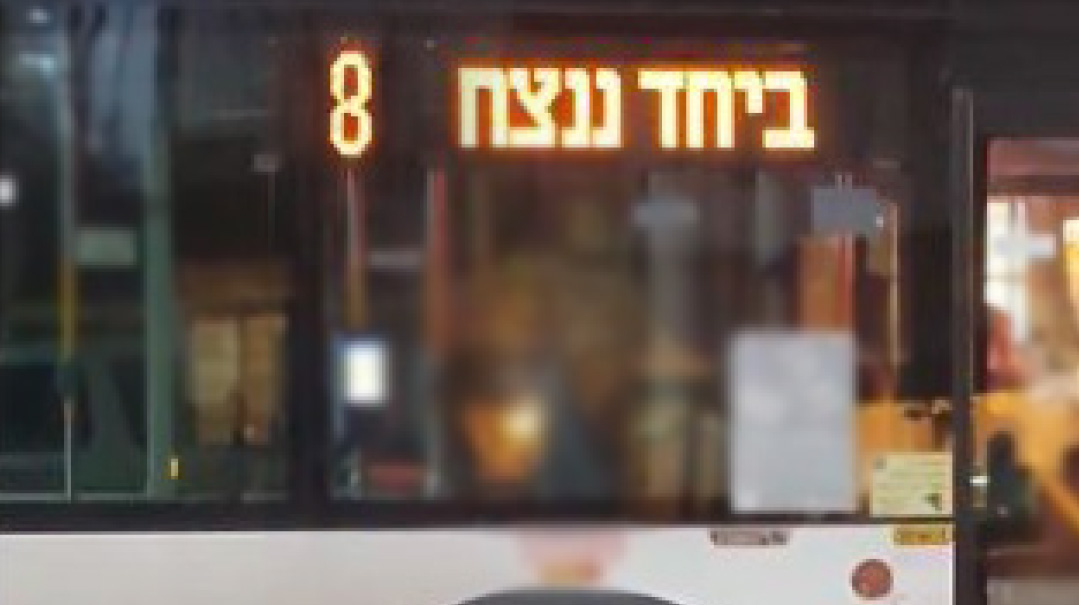Two Jews, Three Visions

It almost became a game of “tell me your war aim and I will tell you who you are”

Beyachad Nenatzeach.
Since Simchas Torah, all the city buses in Israel have been broadcasting this slogan as they lumber along the streets, that oblong LCD display atop the windshield alternately flashing “Route 69 to Givat Shaul,” the final stop of “Har Nof Terminal” and “Together we will win.”
So simple.
When this war was first thrust upon us, it really did seem simple. All Jews were targets. There was no significant distance – not in miles, not in mindset – between the kibbutzim of the Gaza Envelope and the major modern cities of the Center. As far as our enemies are concerned, there wasn’t even any significant distance between the development towns of the South and those enlightened, modern cities. Your views on the Supreme Court or Bibi or the too-messianic or too-secular identity of the state didn’t make you more or less safe.
During those first few weeks, when the hearts of Jews across the globe beat in sync to the footfalls of the IDF soldiers drilling on the Gazan border, we all found succor in Chazal’s account of the Jews living in King Achav’s times. They weren’t faithful to Hashem or his Torah but they were united, and that gave them the merit to triumph on the battlefield. Surely, with our new layer of unity covering the ugly scars of so much dissent and strife just days prior, we, too, would merit a swift victory.
But that’s not exactly what happened. And it leads you to wonder: Sure, we need the Yachad for the Nenatzeach. We need unity to merit victory. But maybe we need to agree on what Nenatzeach means in order to have the Yachad? Maybe there’s only so “together” we can be, if we don’t have a shared definition of what triumph would look like.
On October 8th, “Yachad” meant an unspoken understanding that we would only see good and speak well of other sectors. We were all in this together, and we each had a role and responsibility to keep the Jews of Eretz Yisrael safe.
“Keep people safe” is not a very catchy or impressive war aim, though. Soon a list of goals was publicized. Eradicate Hamas. Return all the hostages. Rip up the principles of the ill-fated “conceptzia”— the unrealistic principles that informed IDF policy — and draft a new, more realistic military doctrine.
The months passed with no victory, and the definition of “nenatzeach” contorted and stretched to include new, different aims. Track down the traitors who disregarded intelligence warnings of imminent attack. Show our mettle by establishing new settlements in Yehuda and Shomron. Cut the rot from its head by sending Bibi packing. Nip any future terrorism in the bud by recapturing and resettling Gaza. Fire the top IDF brass who never informed Bibi of the risks. Bring the PA in to govern Gaza. Never allow the PA in to govern Gaza.
It almost became a game of “tell me your war aim and I will tell you who you are.” As the war went on, all these sectarian affiliations and resentments colored our amateurish assessments of how this war should be run and what it should accomplish.
A
merican educator Stephen Covey made millions and helped many corporations thrive by identifying seven healthy habits of highly successful people, families, and businesses. The bedrock foundation of all those habits is a shared mission statement. In order to lead a fully effective venture, everyone in your family, or your business, or your nonprofit, needs to be on board and have full knowledge of what you’re all about — what you consider success.
Whether a team member works in sales, the creative department, the executive suite, or as the janitor, Covey taught that effective leaders ensure each employee has a clear idea of what your endeavor is trying to achieve and how their role plays into that aim.
A week into this war (which still doesn’t have a widely accepted name – itself a telling fact), I asked one of our news writers, “We’re seeing incredibly unity and support for this new effort, but beyond the talk about ‘teaching them a tough lesson’ and ‘restoring stability and security,’ what is the official vision for victory? What are the metrics to gauge whether the goals for this military campaign have been met? I’d love to read a feature that pinpoints what success would mean.”
One metric is pretty straightforward. And that first week or two, it was the intuitive answer: eradicate Hamas.
It took months for Rear Admiral Daniel Hagari, the official IDF spokesman, to concede that Hamas is a mentality and a movement vastly more encompassing than actual armed forces or even financial support networks. When he said that in front of the microphone, Netanyahu pushed back forcefully: Eradicating Hamas is in fact the aim of this war, he protested; it’s what we promised to do and we are doing it. No one can deny that the brave IDF soldiers have done unbelievably impressive work in rooting out the Hamas fighters and destroying much of their infrastructure. And it might be the case that the IDF spokesman should stick to reporting facts and stay away from ideological analysis. But maybe there is truth in his words.
Another metric is the safe return of the hostages. This is everyone’s hope and prayer. Who can bring up children in a country where citizens are snatched from their beds in their pajamas and left abandoned in enemy territory? For huge portions of the Israeli population, the return of the hostages has become the solitary aim of the war. The Kaplan protest movement, which after October 7th initially redirected its drive and resources and anti-Rightist passion to the families of the hostages, is once again on the streets every Motzei Shabbos, calling for a total hostage release and conflating it with an end to the Netanyahu-led Rightist government.
In contrast, there are families of fallen soldiers who’ve plastered bus stops with photos of baby-faced teens or wise-eyed fathers in glasses, urging a continued fight until “total victory” — no matter what fate ultimately befalls the hostages.
Another metric for a successful end to this war is a “return to normalcy.” Lots of Israelis just want to be normal citizens in a normal country with normal lives. If that means a premature end to this round of “mowing the grass” in Gaza, so be it. They’re weary of the constant demonization in the media, the ICC, and public opinion. They’re tired of having to justify their very existence. They just don’t want to be at war anymore.
Nine months into this terrible war, the country is ostensibly going about its businesses, but in many ways, our hearts are in Gaza (with a worried eye on the North). If you visit any major Israeli city you will see many busy stores packed with customers (and unfortunately, quite a few that were forced to close). You will see teens strolling along shopping strips and young and not-so-young soldiers straddling their heavy guns as they head to their next posting. And you’ll see the buses still rumbling by with their digital promise: Together we will win. A rousing slogan? A tired cliché? A heavenly guarantee? Maybe it’s all that. And maybe it’s also a challenge — to find a shared definition we can rally around.
Netzach means victory, but also endurance. We may not attain a total victory this time; we likely won’t be able to check off every aim on the list. But we are the eternal nation. We hold a Divine promise that the Jewish nation will never be eradicated — that until that final, long-awaited salvation, there will always be another round for Hashem’s favored children.
(Originally featured in Mishpacha, Issue 1020)
Oops! We could not locate your form.







